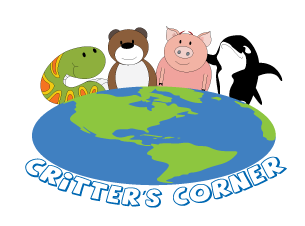

Crocodiles use the natural camouflage of their thick, muddy-colored skin to blend in with their surroundings, while their smooth underbelly, streamlined body, and webbed feet help them swim quickly. A crocodile won't chase his meal too far. They are "ambush predators," who prefer to wait, blending in with their surroundings, until their prey happens by. Then they will burst forward with sudden speed to snatch it. Although crocodiles eat mostly fish, birds, and other animals in their environment, they still remain a threat to humans, so if you see one: Stay away!
Don't believe us? Check out this huge animal, all the way from Green Island, Australia, who is one of the biggest crocodiles in captivity! Notice that, despite his substantial size, he is quick when going after a big chunk of meat the zoo keepers are offering him and his powerful jaws snap shut with an audible "thud." You wouldn't want to meet him in the wild if he was hungry!
*Animal Poetry Bonus*
Has your classroom heard the wonderful poem from the book, Alice in Wonderland, by Lewis Carroll?
How Doth The Little Crocodile
How doth the little crocodile
Improve his shining tail,
And pour the waters of the Nile
On every golden scale!
How cheerfully he seems to grin,
How neatly spreads his claws,
And welcomes little fishes in
With gently smiling jaws!
What are your students' favorite animal poems? Let us know in the comments section!
Do your students want to learn all about he crocodile? Check out the book, Crocodile, by Lee Waters :

Sign up for our FREE Hameray newsletter here and keep up to date on all your favorite titles, giveaways, and more:





















































![6 Fun and Easy Activities to Practice Sequencing [Grades K-1]](http://www.hameraypublishing.com/cdn/shop/articles/Red_Typographic_Announcement_Twitter_Post-5_bf1ae163-a998-4503-aa03-555b038d1b76_600x.png?v=1689961568)